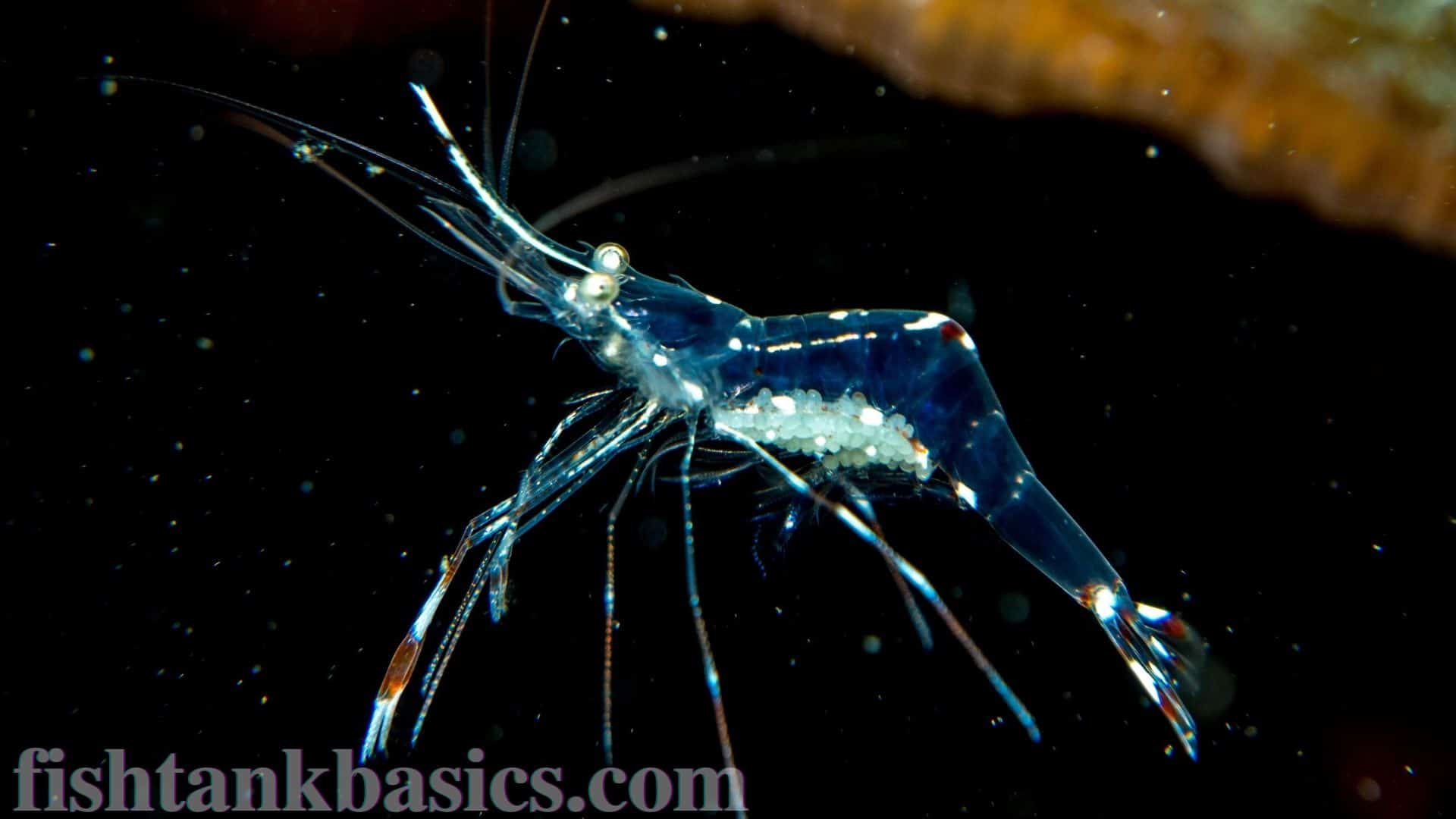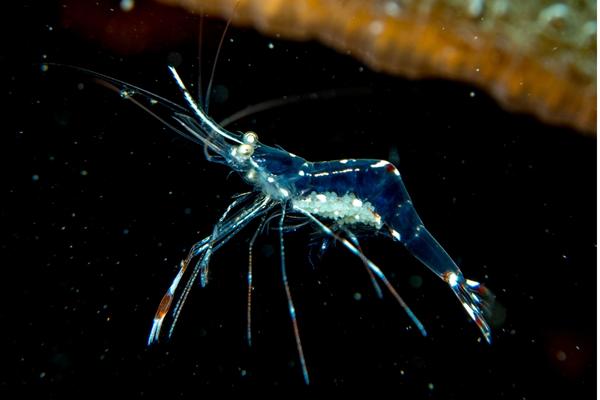Ghost shrimp are small, transparent shrimp. People usually keep ghost shrimp in an aquarium to help with algae or use the shrimp as fish food. But, you need to keep them in a comfortable environment with no predators if you want them to reproduce. Your ghost shrimp will often breed in a safe environment and at the right temperature.

Ghost Shrimp Mating Behavior
Male and female ghost shrimp do different things when they mate. But, both males and females recognize each other’s mating behavior.
Female Mating Behavior
Female ghost shrimp develop 20-30 tiny green specks of eggs on their saddle. When this happens, we say that the shrimp is berried. When berried, you can easily observe the female ghost shrimp from outside the tank. You usually see the saddle near the base of the abdomen.
The saddle of eggs eventually moves down to the rear legs, near the tail. When the eggs move, the female ghost shrimp oxygenate the eggs with a fan-like motion. The female also releases chemicals in the water to alert males that it’s ready to mate.
Male Mating Behavior
Male ghost shrimp pick up on the chemicals released by the female in the water. If more than one, the male shrimp will fight each other for the right to fertilize the female’s eggs. The female chooses her mate based on how well the male ‘fights.’

Encouraging Your Ghost Shrimp To Breed
Breeding ghost shrimp can be a lot of fun. Most breeders will have a tank that is at least 10 gallons. That’s more than enough room for the shrimp’s habitat. It would be best if you provided a gravel substrate with large rocks and aquatic plants to create cover for both the parents and the offspring.
It is best to provide food about an hour after lights out to feed in secret. Feeding your ghost shrimp after dark is best because they are more likely to feel safe and eat. Ghost shrimp eat microscopic particles of algae.
But if none is present in their habitat, sinking pellets are a good alternative. After feeding time is over, remove any uneaten food. Removing the uneaten food stops ammonia buildup, which can also discourage reproduction.
Pregnant Ghost Shrimp Stages:
- Check that you have both males and females
- Look for berried females
- Move females carrying eggs to separate tank
- Wait for the eggs to hatch
- Move the female back to the main tank
- Feed newly hatched baby ghost shrimp
- Move fully grown shimp to main tank
Check To See If You Have Both Males And Females
You should add a pair of ghost shrimp to a tank without any extra shrimp or fish. A shrimp-only tank ensures that they will lay their eggs in peace. You also stop other fish harassing your shrimp.
Fish will also eat baby ghost shrimp. It’s critical not to disturb the aquarium too much once you introduce your shrimp. Any disturbance can cause your shrimp to panic.
Adult female ghost shrimp are much bigger than males. The difference is significant. You will be able to tell the difference when once they are mature. You don’t need to have the same number of each. You can have one male for every two females if you want.
Look For Berried Females
Female ghost shrimp develop 20-30 tiny green specks of eggs on their saddle. When this happens, we say that the shrimp is berried. When berried, you can easily observe the female ghost shrimp from outside the tank.
Move Females Carrying Eggs To A Separate Tank
Most breeders choose to remove their berried females from the main tank and place them in a separate breeding tank. Separation helps ensure no mishaps with other shrimp or fish attempting to eat her eggs. It shouldn’t take more than 2 weeks for males to fertilize a berried female.
So, after a few days, move the females that are carrying eggs to the breeding tank. Move them by catching them with a net and quickly moving them to your breeding tank.
Females have been known to drop their eggs when stressed so don’t make this transfer last too long. If it is easier, move the males instead.
Wait For Eggs To Hatch
Wait for about 22 days for the eggs to hatch. Observe the female and what is happening with the eggs.
You might be able to see two black dots in each egg near the end of the incubation time, which are baby shrimp’s eyes! When they hatch, the female will swim upwards and kick them off of her legs one at a time.
When you see the female kicking away the young, do not disturb her. Shrimp prefer to need to deposit their young in more than one place. In the wild, scattered deposits increase the chances of survival. It shouldn’t take more than an hour.
Move The Female Back To The Main Tank
When a female shrimp is done scattering her babies, move her back to the main tank. If you don’t, there’s a high chance that she’ll eat the baby ghost shrimp. Once the shrimp have hatched, they are very small.
Feed The Newly Hatch Baby Ghost Shrimp
You might not be able to see them, as they are so tiny. Keep feeding the shrimp food for three weeks even if you do not see them. Be sure to grind up large food so that it is small enough for the baby shrimp to eat.
The smaller the particles, the better. Good options are baby brine shrimp, microworms, or powdered spirulina algae. For more information, you can read What To Feed Ghost Shrimp?
Move Full Grown Shrimp To Main Tank
After 1 to 2 weeks, the ghost shrimp will grow all their legs and develop into tiny versions of the adults. They will be full-grown after five weeks, and you may then transfer them to the main tank.
Final Thoughts
Ghost shrimp are easy to take care of and breed as long as you give them what they need. Make sure they have enough food and oxygen, and they will start reproducing.
Watch for the mating behaviors of males and females. Watch how the female gets pregnant, and watch her eggs turn from green to white as they become fertilized. Then pay attention to how she deposits her eggs when they start hatching.
After the fry hatch, put them in their own nursery tank or move adults to a separate tank. If shrimp fry stay with the adults, they could get eaten. Most importantly, feed the baby shrimp often to prevent them from dying.
Table of Contents

